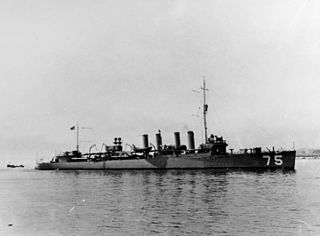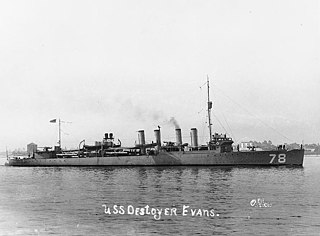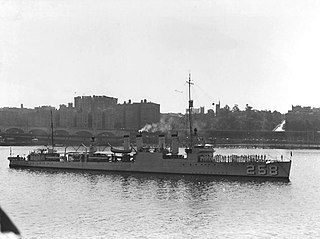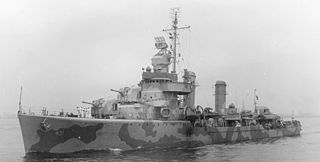
USS Ellyson (DD-454/DMS-19), a Gleaves-class destroyer, is the only ship of the United States Navy to be named for Theodore Gordon Ellyson, a submariner who became the first officer of the U.S. Navy to be designated a naval aviator.

USS Buchanan (DD-131), named for Franklin Buchanan, was a Wickes-class destroyer in the United States Navy.

USS Whipple, a Clemson-class destroyer was the second ship of the United States Navy named in honor of Captain Abraham Whipple (1733–1819), who served in the Continental Navy.

The first USS Wickes (DD-75) was the lead ship of her class of destroyers in the United States Navy during World War I, later transferred to the Royal Navy as HMS Montgomery. She has been the only ship of the Royal Navy to bear the name Montgomery.

The first USS Philip (DD–76) was a Wickes-class destroyer in the United States Navy during World War I, later transferred to the Royal Navy as HMS Lancaster. She was named for John Woodward Philip.

The first USS Evans (DD–78) was a Wickes-class destroyer in the United States Navy during World War I, later transferred to the Royal Navy as HMS Mansfield.

USS Fairfax (DD-93) was a Wickes-class destroyer in the United States Navy during World War I, later transferred for World War II service first to the Royal Navy as HMS Richmond (G88), a Town-class destroyer, and then to the Soviet Navy as Zhivuchy.

The first USS Twiggs (DD–127) was a Wickes-class destroyer in the United States Navy during World War I. She was named for Major Levi Twiggs. She was later transferred to the Royal Navy, as HMS Leamington and to the Soviet Navy as Zhguchy, before returning to Britain to star in the film The Gift Horse, which depicts the St. Nazaire Raid.

USS Crowninshield (DD–134) was a Wickes-class destroyer in the United States Navy between World War I and World War II. She was named for Benjamin Williams Crowninshield. In World War II she was transferred to the Royal Navy where she was named HMS Chelsea, and subsequently to the Soviet Navy where she was named Derzky.

The first USS Yarnall (DD–143) was a Wickes-class destroyer in the United States Navy during World War I later transferred to the Royal Navy as HMS Lincoln, to the Royal Norwegian Navy as HNoMS Lincoln, and subsequently to the Soviet Navy as Druzhny.

USS Welborn C. Wood (DD-195) was a Clemson-class destroyer in the United States Navy during World War II. She served with the United States Coast Guard as USCGD Wood. She was later transferred to the Royal Navy as HMS Chesterfield.

USS McCormick (DD-223/AG-118) was a Clemson-class destroyer in the United States Navy during World War II. She was named for Lieutenant, junior grade Alexander McCormick, Jr.

The first USS McCook (DD-252) was a Clemson-class destroyer in the United States Navy. Entering service in 1919, the ship had a brief active life before being placed in the reserve fleet. Reactivated for World War II, the ship was transferred to the Royal Navy and then to the Royal Canadian Navy and renamed HMCS St. Croix. Assigned as a convoy escort in the Battle of the Atlantic, St. Croix was torpedoed and sunk on 20 September 1943.

The second USS Aulick (DD-258) was a Clemson-class destroyer in the United States Navy and transferred to the Royal Navy where she served as HMS Burnham (H82) during World War II.

The first USS Laub (DD-263) was a Clemson-class destroyer in the United States Navy and transferred to the Royal Navy where she served as HMS Burwell (H94) during World War II. She was named for Henry Laub.

USS Plunkett (DD-431), a Gleaves-class destroyer, is the only ship of the United States Navy to be named for Rear Admiral Charles Peshall Plunkett.

USS Rodman (DD-456/DMS-21), a Gleaves-class destroyer, is the first ship of the United States Navy to be named for Admiral Hugh Rodman.

USS McCalla (DD-488), a Gleaves-class destroyer, was the second ship of the United States Navy to be named for Bowman H. McCalla, who served during the Spanish–American War and would eventually attain the rank of rear admiral.

The second USS Mayrant (DD-402) was a Benham-class destroyer in the United States Navy, the second ship named for John Mayrant. Commissioned shortly before World War II, she was primarily active in the Atlantic theater of the war, and was decommissioned after being used as a target in the Operation Crossroads atomic weapons tests.

USS Benson (DD-421) was the lead ship of her class of destroyers in the United States Navy during World War II. She was named for Admiral William S. Benson (1855–1932).




















